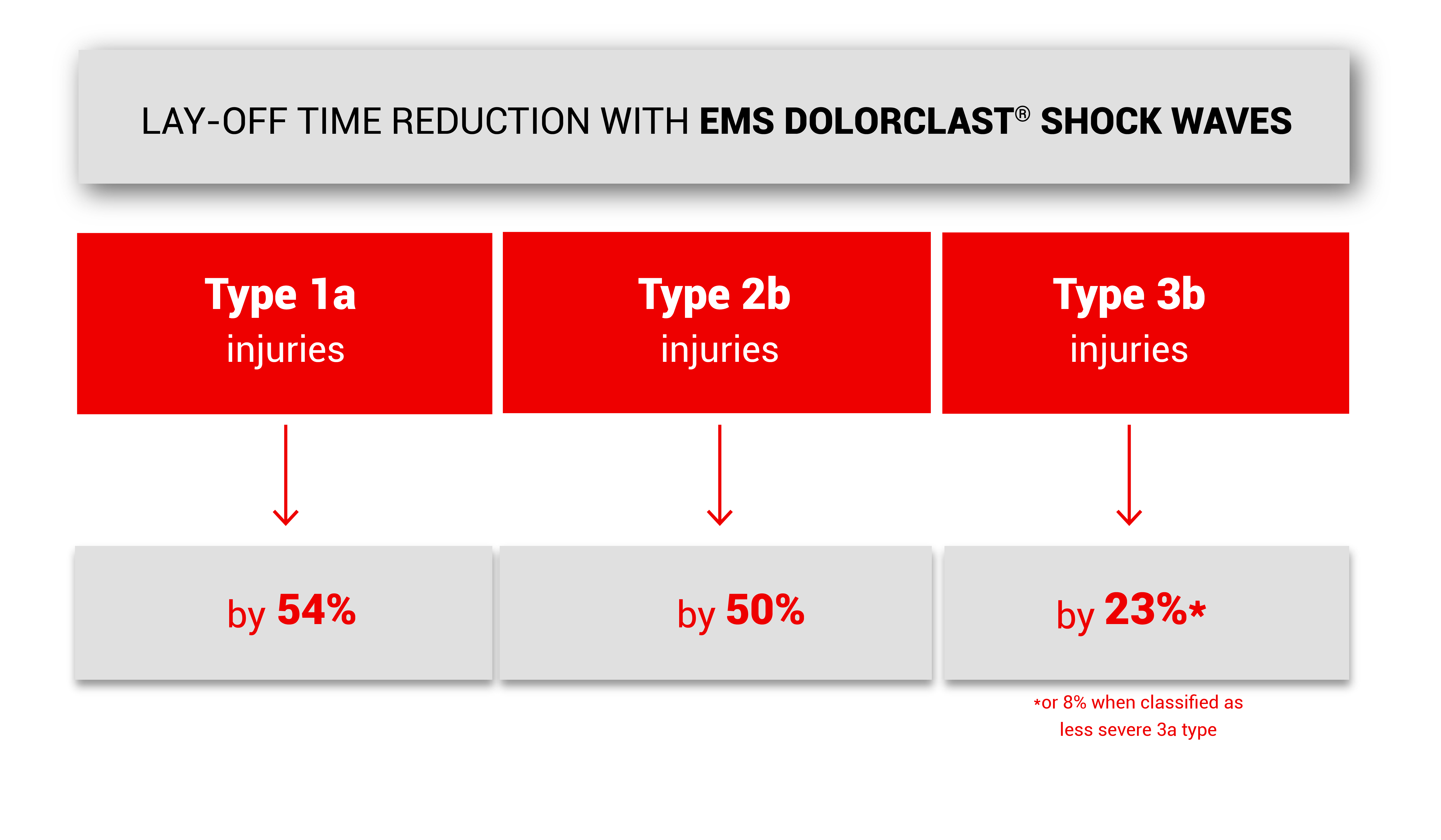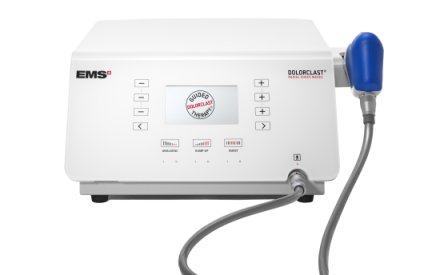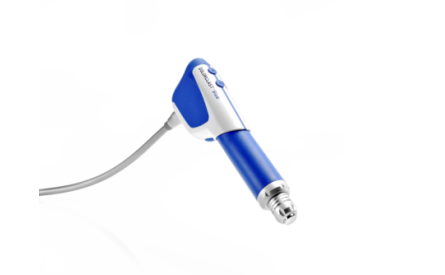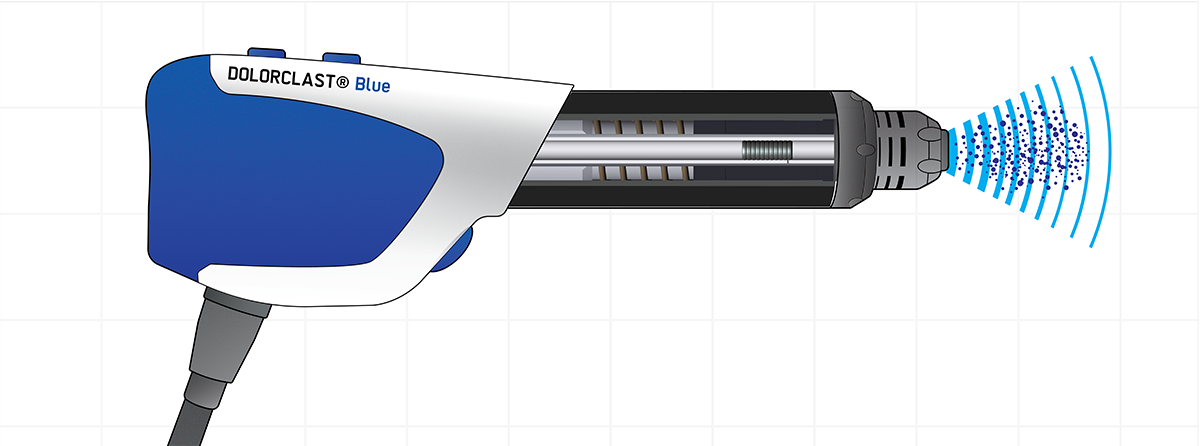
RENDIMIENTO SUPERIOR DE LAS ONDAS DE CHOQUE RADIALES EMS DOLORCLAST
El tratamiento con ondas de choque extracorpóreas radiales (rESWT) es una modalidad de tratamiento segura y eficaz para diversas afecciones musculoesqueléticas. Su eficacia depende de la salida de energía en los ajustes del dispositivo basados en la evidencia y clínicamente relevantes.1 Por lo tanto, los investigadores empezaron a investigar en 2015 cómo difieren los diferentes dispositivos de rESWT en cuanto a su salida de energía.2
Estas diferencias se investigaron más a fondo en un reciente estudio comparativo realizado por Nina Reinhardt y sus colegas del Instituto Helmholtz de Ingeniería Biomédica, RWTH Aachen (Aquisgrán, Alemania).3 Los autores de este estudio compararon el último dispositivo de EMS, DolorClast® Radial Shock Waves y el Storz MASTERPULS® 200 ultra. Encontraron diferencias sustanciales en cuanto a la energía total que puede suministrarse a un paciente.3
Los dispositivos de ondas de choque radiales varían significativamente en su producción de energía.
¿Por qué es importante para los profesionales? Porque las últimas investigaciones científicas y clínicas han confirmado la importancia de una mayor entrega de energía para obtener mejores resultados en el tratamiento. Sin embargo, no todos los dispositivos son capaces de suministrar una energía elevada. Lee más sobre estas reflexiones a continuación.
Nuevo estudio que compara las ondas de choque radiales DolorClast® de EMS y los dispositivos MASTERPULS® 200 ultra de Storz
Influencia de la tasa de repetición de pulsos en la salida acústica de los dispositivos de ondas de presión balísticas
Nina Reinhardt*, Jens Wegenaer y Matías de la Fuente. Enlace al estudio completo Link to full study
En este nuevo estudio de banco de pruebas, se han investigado dos dispositivos de ondas de presión balísticas y su salida de energía con diferentes ajustes en una configuración de prueba experimental de alta precisión:
- Ondas de choque radiales EMS DolorClast® con Mango BLUE y aplicador de 15 mm
- Storz MASTERPULS® 200 Ultra con Mango FALCON y aplicador de 15 mm
Ambos dispositivos se utilizaron hasta sus ajustes de salida de energía más altos posibles.
Los resultados de este est
- La entrega máxima de energía4 disminuyó bruscamente, hasta el 90,2%, en el caso del MASTERPULS® 200 ultra de Storz Medical.
- Sin embargo, sólo disminuyó ligeramente, un 18,8%, para el dispositivo EMS DolorClast® Radial Shock Waves.
DolorClast® Radial Shock Waves suministra alta energía en todas las frecuencias
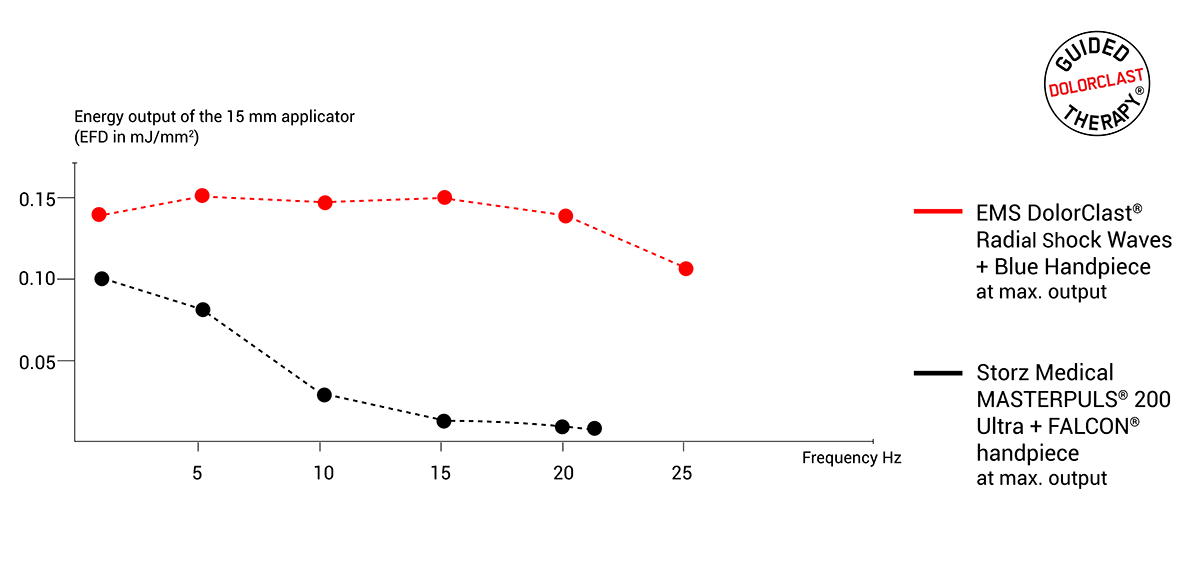
El dispositivo DolorClast®️ Radial Shock Waves de EMS consiguió suministrar una energía clínicamente relevante en todos los niveles de frecuencia. Esto es importante para la práctica clínica, porque los resultados clínicos requieren que se suministre suficiente energía al tejido.
Reinhardt et al. (2022) llegaron a la conclusión de que los niveles de energía indicados por el fabricante a 1 Hz no pueden garantizar los resultados a frecuencias más altas.3 El estudio demostró que el dispositivo de Ondas de Choque Radiales DolorClast®️ de EMS garantiza una elevada salida de energía en todos los ajustes de frecuencia.
¿De dónde provienen las diferencias en el suministro de energía?
Durante más de 20 años, la onda de choque radial DolorClast® de EMS ha seguido la evidencia clínica: Para conseguir los mejores resultados terapéuticos, la terapia de ondas de choque de alta energía ha demostrado ser la más eficaz. El suministro de alta energía de los dispositivos de ondas de choque radiales DolorClast® de EMS es posible gracias a la combinación de la gestión de aire altamente eficaz de los compresores y el diseño exclusivo de los mangos EVO BLUE y BLUE.5
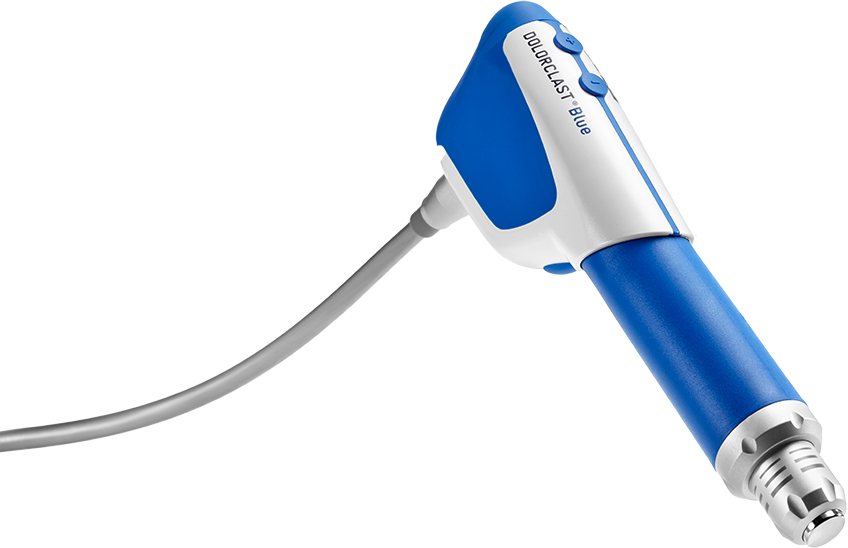
EMS ha llevado la física al límite para conseguir la máxima salida de energía en todas las frecuencias para tratar con éxito las indicaciones de la ortopedia y la medicina deportiva.
- La exclusiva tecnología de 2 compresores proporciona una presión de aire constante al mango DolorClast® BLUE.
- Gestión optimizada del aire en el mango para una velocidad máxima del proyectil.
El resultado son ondas de choque radiales optimizadas para suministrar una energía elevada, estable y reproducible a la zona de tratamiento. Las ondas de choque radiales DolorClast® proporcionan hasta diez veces más energía que el MASTERPULS® 200 ultra de Storz.3
¿Qué relevancia tienen la salida de alta energía y la frecuencia para la práctica clínica?
El tratamiento con ondas de choque radiales de alta energía produce resultados terapéuticos superiores a los del tratamiento con ondas de choque radiales de baja energía.
Esto ha sido confirmado de nuevo por un estudio reciente de 2021, en el que se investigó el tratamiento con ondas de choque radiales de alta y baja energía y su efecto en el alivio del dolor (VAS) en pacientes con osteoartritis de rodilla.6 En este estudio, se utilizó el mango DolorClast® EVO Blue con un aplicador de 10 mm a una frecuencia de choque de 8 Hz.
Este estudio demostró que la terapia de alta energía (0,24 mJ/mm2) dio mejores resultados que la de baja energía (0,12 mJ/mm2).
Además, la baja energía no pudo compensarse aumentando el número de descargas, ya que esto último no dio lugar a un mejor resultado del tratamiento.6
Por lo tanto, los facultativos deben elegir un dispositivo de ESMR que proporcione una salida de energía elevada.
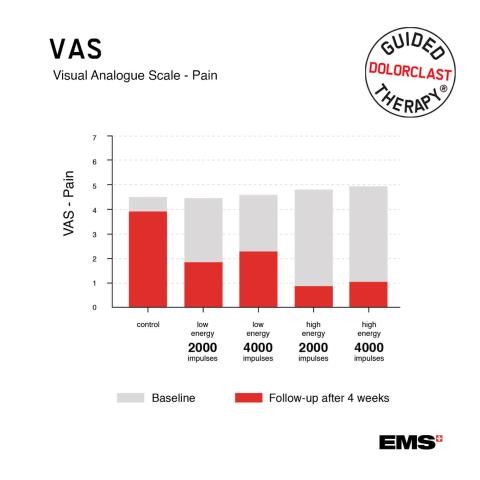
La terapia de ondas de choque radiales puede reducir los tiempos de inactividad en los deportes de élite y disminuir las tasas de reincidencia.
Una colaboración entre investigadores de la Universidad Ludwig-Maximilians de Múnich (Múnich, Alemania) y el personal médico de un equipo de fútbol de élite que compite en la primera/segunda Bundesliga alemana evaluó retrospectivamente el tratamiento y los tiempos de recuperación de 31 futbolistas profesionales, todos ellos con lesiones musculares agudas.7
Las principales conclusiones de este estudio fueron las siguientes
- La incorporación de la rESWT/fESWT a un enfoque terapéutico multimodal es segura, eficaz y beneficiosa para los deportistas que sufren diversas lesiones musculares.
- Los tiempos medios de reposo tras las lesiones musculares de tipo 1a (tirantez/hipertonía muscular) y 2b (lesión por distensión muscular) fueron un 50% más cortos que los casos comparables recogidos en la literatura.
Los tratamientos durante este estudio se realizaron en la mayoría de los casos a 20 Hz. Los resultados positivos se relacionaron con la alta entrega de energía proporcionada por los dispositivos EMS DolorClast®️ utilizados a altas frecuencias.
Resumen
En resumen, al utilizar un dispositivo de ondas de choque radiales EMS DolorClast®, se beneficiará de:
- Alta energía en todas las frecuencias de tratamiento
- Resultados del tratamiento clínicamente probados
- Tratamientos más cortos para mejorar la experiencia de los pacientes
- Mayor éxito en su consulta
Este es el objetivo de la terapia DolorClast® guiada.
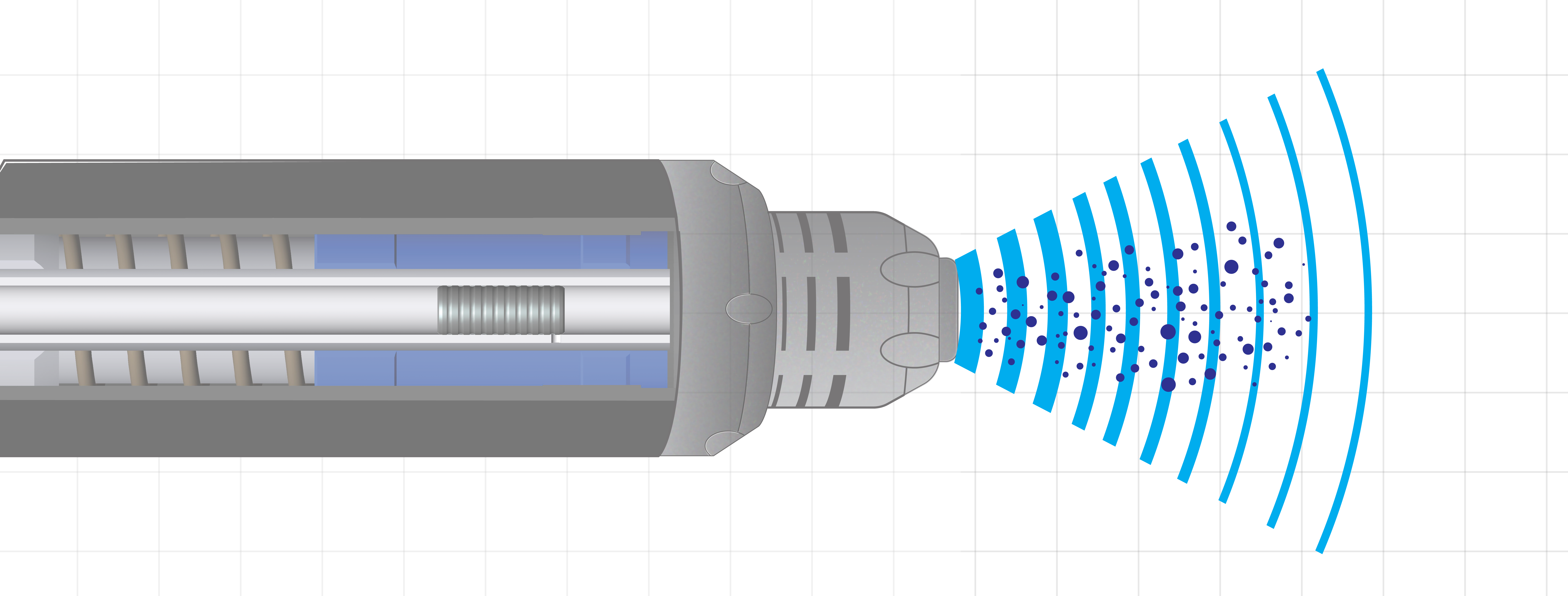
El estudio comparativo realizado por Reinhardt et al. (2022)3 demostró que el dispositivo de ondas de choque radiales DolorClast® suministraba más energía que el Storz MASTERPULS® 200 ultra, especialmente en los ajustes de alta frecuencia aplicados en la práctica.3
Los efectos conseguidos por el dispositivo de ondas de choque radiales DolorClast® de EMS no pueden lograrse con dispositivos con una salida de energía significativamente menor.
Lo demostramos: Los dispositivos EMS DolorClast® son líderes en el campo de las pruebas clínicas y los resultados terapéuticos
Más del 50 % de todos los ensayos clínicos de nivel 1 publicados con un dispositivo de ondas de choque radiales se realizan con un dispositivo EMS Dolorclast®.1,8
En el 80% de estos estudios, los tratamientos con dispositivos de ondas de choque radiales EMS DolorClast® demostraron mejores resultados clínicos que los grupos de control.1
Más del 60% de todos los estudios que demostraron los efectos celulares y biológicos de las ondas de choque radiales se realizaron con dispositivos EMS DolorClast®.9
Es posible que los resultados de estos estudios no se apliquen a otros dispositivos de ondas de choque radiales, que no suministran la misma salida de energía.
1) Schmitz C, Császár NB, Milz S, Schieker M, Maffulli N, Rompe JD, Furia JP. Efficacy and safety of extracorporeal shock wave therapy for orthopedic conditions: a systematic review on studies listed in the PEDro database. Br Med Bull 2015;116(1):115-38.
2) Császár NB, Angstman NB, Milz S, Sprecher CM, Kobel P, Farhat M, Furia JP, Schmitz C. Radial shock wave devices generate cavitation. PLoS One 2015;10(10):e0140541.
3) Reinhardt N, Wegenaer J, de la Fuente M. Influence of the pulse repetition rate on the acoustic output of ballistic pressure wave devices. Sci Rep 2022;12(1):18060.
4)Measured by the positive pulse intensity integral (which is equivalent to the energy flux density; EFD)
5) The EVO Blue and the latest generation BLUE handpiece both use the same technology and therefore deliver almost identical energy outputs. On the other hand, the compressor technology and the power input measured in bar is of minor importance, as the energy management and transformation in the handpiece is the decisive criteria for energy output.
6) Zhang YF, Liu Y, Chou SW, Weng H. Dose-related effects of radial extracorporeal shock wave therapy for knee osteoarthritis: A randomized controlled trial. J Rehabil Med 2021;53(1):jrm00144.
7) Morgan JPM, Hamm M, Schmitz C, Brem MH. Return to play after treating acute muscle injuries in elite football players with radial extracorporeal shock wave therapy. J Orthop Surg Res 2021;16(1):708.
8) Randomized controlled clinical trials (Evidence Based Medicine Level 1) are defined as studies providing evidence at the highest level. It is an agreed global research standard.
9) Wuerfel T, Schmitz C, Jokinen LLJ. The effects of the exposure of musculoskeletal tissue to extracorporeal shock waves. Biomedicines 2022;10(5):1084.

